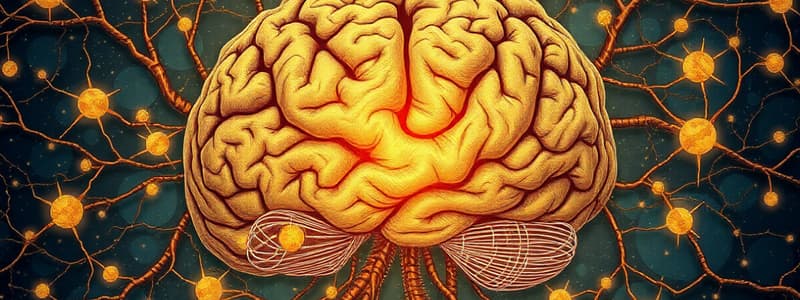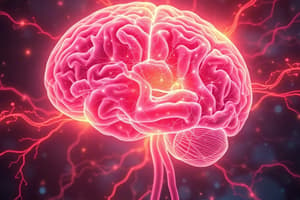Podcast
Questions and Answers
Which statement best describes the modern perspective on the relationship between the mind and body?
Which statement best describes the modern perspective on the relationship between the mind and body?
- Psychological experiences are completely independent of physical processes.
- Biological processes underlie behavior and thought, and are also modified by experience. (correct)
- The mind and body are separate entities that do not influence each other.
- The mind is solely responsible for controlling the body's actions.
How do enriched environments affect brain development in rats, according to Rosenzweig & Bennet (1972)?
How do enriched environments affect brain development in rats, according to Rosenzweig & Bennet (1972)?
- Enriched environments promote the development of more connections between neurons. (correct)
- Enriched environments lead to a decrease in connections between neurons.
- Enriched environments cause neurons to become less active.
- Enriched environments have no significant impact on neuronal connections.
What effect does touch deprivation have on infant rats, according to Schanburg (2003)?
What effect does touch deprivation have on infant rats, according to Schanburg (2003)?
- Increased growth, fewer neural connections, and lower stress hormones.
- Decreased growth, fewer neural connections, and higher stress hormones. (correct)
- Decreased growth, more neural connections, and higher stress hormones.
- Increased growth, more neural connections, and lower stress hormones.
What benefits have been observed in premature infants who receive massage, according to Field (2010)?
What benefits have been observed in premature infants who receive massage, according to Field (2010)?
Which of the following best describes the primary function of the nervous system?
Which of the following best describes the primary function of the nervous system?
What is the relationship between the nervous system and psychological experience?
What is the relationship between the nervous system and psychological experience?
Which division of the nervous system includes the brain and spinal cord?
Which division of the nervous system includes the brain and spinal cord?
What is the primary role of the parasympathetic nervous system?
What is the primary role of the parasympathetic nervous system?
Which of the following is the most accurate estimate of synaptic connections in the human brain?
Which of the following is the most accurate estimate of synaptic connections in the human brain?
If a person is having trouble sensing the environment around them, which type of neuron is likely to be impaired?
If a person is having trouble sensing the environment around them, which type of neuron is likely to be impaired?
Which of the following functions is NOT primarily associated with neurons?
Which of the following functions is NOT primarily associated with neurons?
What is the primary role of motor neurons within the nervous system?
What is the primary role of motor neurons within the nervous system?
Glial cells perform several important functions. Which of the following is NOT a function of glial cells?
Glial cells perform several important functions. Which of the following is NOT a function of glial cells?
What does the phrase 'Neurons that fire together, stay together' refer to?
What does the phrase 'Neurons that fire together, stay together' refer to?
Which feature distinguishes neurons from other cells in the body?
Which feature distinguishes neurons from other cells in the body?
An action potential can best be described as:
An action potential can best be described as:
Which of the following best describes the function of dendrites in a neuron?
Which of the following best describes the function of dendrites in a neuron?
What is the primary role of the myelin sheath that covers some axons?
What is the primary role of the myelin sheath that covers some axons?
What is the 'all or nothing' principle in the context of neuronal firing?
What is the 'all or nothing' principle in the context of neuronal firing?
Within a neuron, neurotransmitters are primarily stored in which structure?
Within a neuron, neurotransmitters are primarily stored in which structure?
What is the key function of nerves within the peripheral nervous system?
What is the key function of nerves within the peripheral nervous system?
Communication between two adjacent neurons is accomplished via
Communication between two adjacent neurons is accomplished via
Which of the following describes the likely effect of a drug that blocks the reuptake of a particular neurotransmitter?
Which of the following describes the likely effect of a drug that blocks the reuptake of a particular neurotransmitter?
Which of the following statements accurately describes the relationship between axons and nerves?
Which of the following statements accurately describes the relationship between axons and nerves?
Flashcards
Neurons
Neurons
The functional units of the nervous system, communicating cells that organize our experiences.
Sensory Neurons
Sensory Neurons
Carry incoming information from the sense receptors to the CNS.
Motor Neurons
Motor Neurons
Carry outgoing information from the CNS to muscles and glands.
Interneurons
Interneurons
Signup and view all the flashcards
Glial Cells
Glial Cells
Signup and view all the flashcards
Neurons Growing New Networks
Neurons Growing New Networks
Signup and view all the flashcards
Action Potential
Action Potential
Signup and view all the flashcards
Specialized Neuronal Structures
Specialized Neuronal Structures
Signup and view all the flashcards
Mind-Body Dualism
Mind-Body Dualism
Signup and view all the flashcards
Materialism (in Psychology)
Materialism (in Psychology)
Signup and view all the flashcards
Biological Basis of Behavior
Biological Basis of Behavior
Signup and view all the flashcards
Nervous System
Nervous System
Signup and view all the flashcards
Nervous System's Role
Nervous System's Role
Signup and view all the flashcards
Central Nervous System (CNS)
Central Nervous System (CNS)
Signup and view all the flashcards
Peripheral Nervous System (PNS)
Peripheral Nervous System (PNS)
Signup and view all the flashcards
Somatic Nervous System
Somatic Nervous System
Signup and view all the flashcards
Neuron Nucleus
Neuron Nucleus
Signup and view all the flashcards
Dendrites
Dendrites
Signup and view all the flashcards
Terminal Ends (Buttons)
Terminal Ends (Buttons)
Signup and view all the flashcards
Axon
Axon
Signup and view all the flashcards
Myelin Sheath
Myelin Sheath
Signup and view all the flashcards
Synaptic Vesicles
Synaptic Vesicles
Signup and view all the flashcards
Neurotransmitters
Neurotransmitters
Signup and view all the flashcards
Synaptic Gap (Synapse)
Synaptic Gap (Synapse)
Signup and view all the flashcards
Study Notes
- The biology of the mind includes serotonin and dopamine pathways.
Mind and Body
- A person's mind was thought to be separate from the body for most of history, called mind-body dualism.
- The relatively new idea of materialism considers psychological experience completely tied to our physical beings.
Biological Understanding of Behavior
- Biological and biochemical processes underlie all human behavior and thought.
- Biology alone does not control actions, rather environmental forces, actions, and choices also modify the brain.
- Physical and chemical changes occur in the brain whenever we learn, remember, feel, or act.
Biological Understanding of Behavior and Mental Processes
- Rats in enriched environments develop more neuron connections than those in boring environments (Rosenzweig & Bennet, 1972).
- Rats deprived of touch in infancy grow less, have fewer neuron connections, and higher stress hormones (Schanburg, 2003).
- Premature infants who receive massage grow faster and show better cognitive development than those who aren't touched (Field, 2010).
Nervous System
- The nervous system supplies the physical basis for psychological experience.
- It is the speedy, electrochemical communication system that both directs and is influenced by behavior and thought.
- The two major subsystems are the Central Nervous System (CNS) and the Peripheral Nervous System (PNS).
- The CNS contains the brain and spinal cord.
- The PNS contains all other nerve cells.
- The PNS is divided into the Somatic Nervous System and the Autonomic Nervous System.
- The Somatic Nervous System controls skeletal muscles.
- The Autonomic Nervous System controls glands and other muscles.
- The Autonomic Nervous System is divided into the Sympathetic Nervous System and the Parasympathetic Nervous System.
- The Sympathetic Nervous System arouses the body, mobilizing energy in stressful situations.
- The Parasympathetic Nervous System calms the body, conserving energy and maintaining homeostasis.
Neurons
- Neurons are the functional unit of the nervous system.
- Neurons communicate with each other and organize every aspect of our experience.
- There are approximately 100,000,000,000 neurons in the human brain and they form complex networks.
- Neurons may have 10,000 times more connections between them than there are neurons themselves.
Main Jobs of Neurons
- Relaying information
- Storing information, covering all memories and data.
- Regulating all internal processes.
- Sensing information from the outside world (eyes, ears, nose, etc.)
- Making and Releasing neurotransmitters (dopamine, serotonin, etc.)
- Working with the Endocrine System (hormones)
Kinds of Neurons
- Sensory neurons carry incoming information from the sense receptors to the CNS.
- Motor Neurons carry outgoing information from the CNS to muscles and glands.
- Interneurons connect the two neurons.
Glial Cells
- Glial cells are important helper cells with many functions.
- Glial cells help nourish neurons, move neurons around, and clean up debris.
- Glial cells form myelin, repair neurons, and attack intruders, such as viruses and bacteria.
- There are 10 times more glia than neurons, so the brain is mostly glia.
Neuron Structure
- Neurons are similar to other cells in the body, including a cell membrane, a nucleus with organelles, and genetic material.
- Neurons have specialized structures that allow for communications, including axons, dendrites, terminal buttons, synaptic vesicles, and receptors.
Axons
- Single fibers that extend from the neuron.
- Axons can be either microscopic or more than 2 feet in length.
- Axons serve as transmitter for the cell, and carry nerve impulses toward other neurons
- Many axons are covered with a myelin sheath, that is a fatty substance that insulates it from other neurons, making nerve signals move faster.
- The area called the terminal button is at the end of the axon fiber.
- The small sacks inside a terminal button is called synaptic vesicles.
- Chemicals in those vesicles are called neurotransmitters.
Nerves vs. Neurons
- Neurons are single nerve cells.
- Nerves consist of neural “cables" containing many axons.
- Nerves are part of the peripheral nervous system, and connect muscles, glands, and sense organs to the central nervous system.
Dendrites
- Dendrites are multiple, usually shorter fibers, which receive signals from the axons of other neurons.
- Dendrites are cells “receivers”.
Synapses
- Synapses occur where axons and dendrites of adjacent cells never touch.
- Chemicals called Neurotransmitters are released in the gap between them .
- All communication between neurons is accomplished via neurotransmitters migrating across the synaptic gap and binding with receptor sites on the dendrites of adjacent neurons.
Connectome
- The structure and function of our brains, may make us who we are.
- Neurons communicate.
Studying That Suits You
Use AI to generate personalized quizzes and flashcards to suit your learning preferences.




